Advantages and Disadvantages of Mass Production
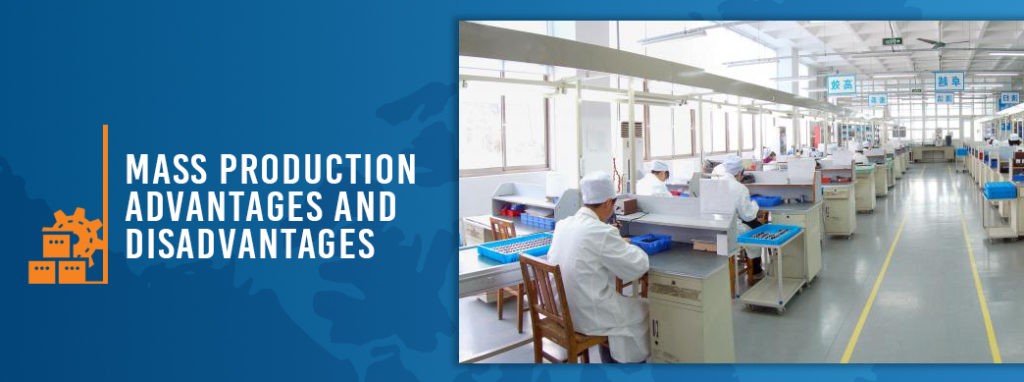
In this article:
- What Is Mass Production?
- What’s the History of Mass Production?
- The Advantages and Disadvantages of Mass Production
- Why Mass Production Is Important
- Subscribe to Our Blog for More Info
Manufacturing is the largest sector in the U.S. economy, adding a value of over $2 trillion each year. Although factory employment has decreased over the years, the U.S. produces 40 percent more than it did in the 1990s. Thanks to mass production, the U.S. remains one of the top manufacturing countries in the world.
Manufacturers understand the importance of mass production. Mass production has enabled the country to grow and is part of other important sectors in the economy such as transportation and retail. However, there are also disadvantages that come with the effects of mass production. In this post, we’ll explore what mass production means, how it began and how it affects our lives.
What Is Mass Production?
Mass production refers to the manufacturing of large quantities of products using efficient methods. Mass production is typically accomplished by using assembly lines, automation technology or robotics. Manufacturers who use mass production techniques must establish highly organized methods of production. The main characteristics of mass production are:
- Specialized machines
- Interchangeable parts
- Division of labor
Being able to produce high volumes at great speed gives companies a competitive edge. By using automated technology or robotics to produce goods, companies also require fewer workers.
1. Mass Production Examples

Mass production methods can be found in all kinds of industries. For example, many fast food chains use mass production techniques, such as building meals in an assembly-line-like fashion, to quickly deliver products to customers.
An early example of mass production is when Henry Ford installed the first moving assembly line in 1913. Ford’s assembly line enabled him to mass produce entire automobiles. As a result, Ford’s Model T was available at a lower cost because they were built more efficiently. Initially, Ford broke his assembly line into 84 steps and trained each worker to work on just one step. In 1914, he added a mechanized belt to accelerate the process. Eventually, Ford’s method of mass production reduced the time it took to build a car from over 12 hours to two and a half hours.
Today, some manufacturers use robotics to mass produce goods and keep up with competitors. For example, CMC Food, a food manufacturer in New Jersey, invested in robots to speed up the manufacturing process. One of their robots is used for palletizing at a speed of 144,000 eggs per hour. In the past, workers had to feed 10 dozen eggs into a machine at one time.
What’s the History of Mass Production?
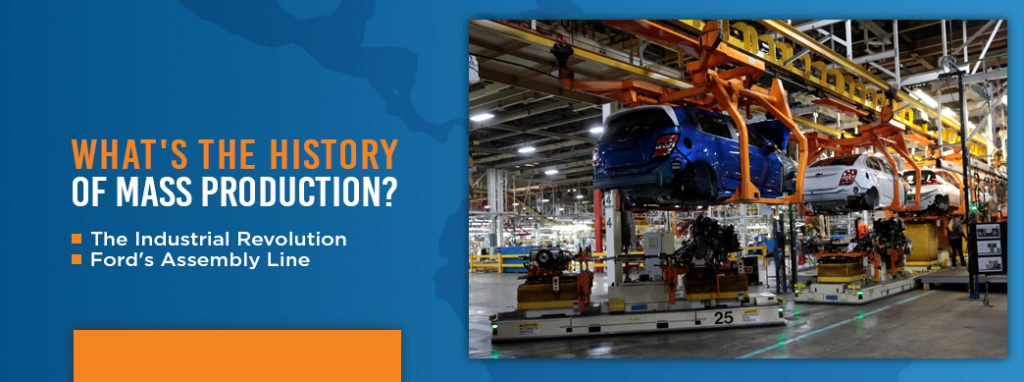
Before the Industrial Revolution, people produced goods using general tools or basic machinery within their homes or shops – mass production was not a part of everyday life. Several innovations in the 1700s, particularly within the textile industry, played important roles in industrialization. Other inventions, such as the development of the steam engine which was used to power machinery and locomotives, led to the Industrial Revolution. In turn, the Industrial Revolution generated new concepts which eventually gave birth to mass production techniques.
1. The Industrial Revolution
The Industrial Revolution began in Britain during the 18th century. During this time, manufacturers started using machines to accelerate textile production. Also during this period, James Watt improved steam engine design, and he used one successfully in a cotton mill. Soon, steam engines replaced animals, humans and water as a reliable energy source.
Another innovator, Marc Brunel, developed a production line to manufacture pulleys for sailing ships. Brunel’s machine tools were designed by Henry Maudslay. Maudslay recognized the value of precision tools and how they could make identical pieces.
By the middle of the 19th century, factories in Europe and America embraced the ideas of dividing labor, using machines to manufacture goods and assembling standardized parts for efficient production. Also, the expansion of transportation systems accelerated the manufacturing process by delivering raw materials faster and shipping finished goods over larger distances quicker.
2. Ford’s Assembly Line
The concept of the mass production process was introduced when Henry Ford decided to produce an inexpensive vehicle many Americans could afford. Although innovators like Eli Whitney and Samuel Colt were committed to mechanized production, Ford is credited with bringing true mass production to the manufacturing world with his use of the moving assembly line. It was Ford’s assembly line that enabled his company to keep up with consumer demand and sell Model Ts at prices consumers felt good about. His mass production techniques soon spread to other automobile manufacturers and other industries.
The Advantages and Disadvantages of Mass Production
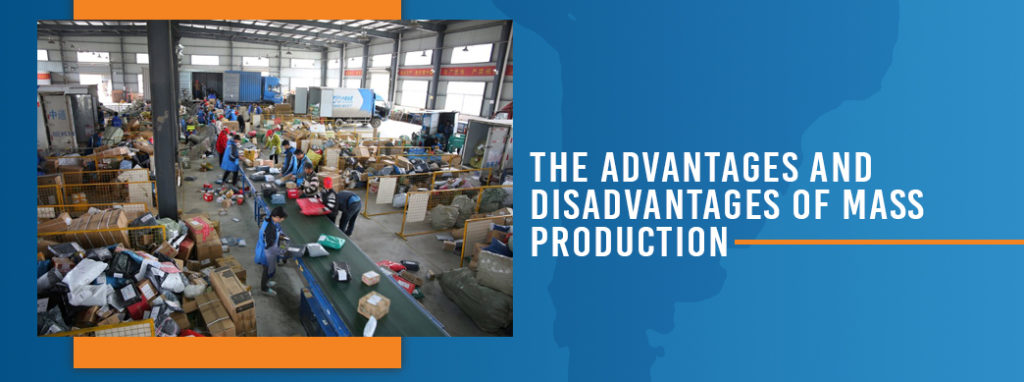
Have you ever seen a film or read a book that paints a bleak picture of humans and robots working side by side in an assembly line? Or wondered how did mass production affect consumers? Mass production has had a profound impact on American culture and lifestyle – in both good and bad ways. However, not everything about mass production looks like a scene from a 1980s horror film. Manufacturers around the globe know that mass production has many benefits, for both companies and consumers.
1. Mass Production Advantages
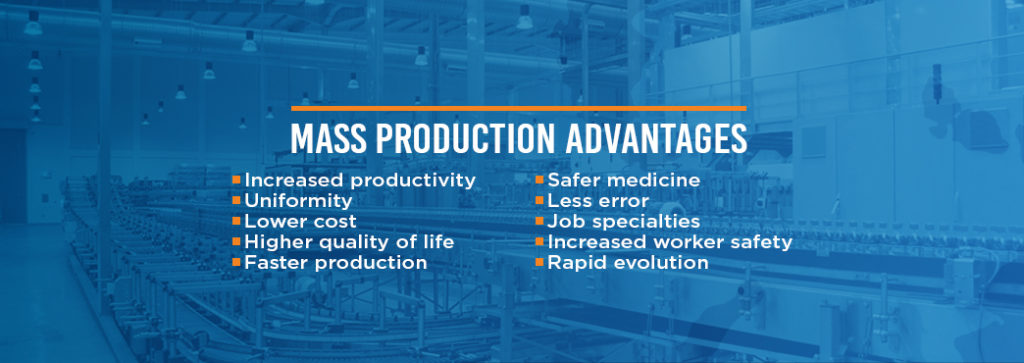
Most people use mass-produced items every day in one way or the other, from the clothes they wear to the beverages they drink. It would be hard to find someone who doesn’t own something that had been mass produced. There are many advantages to mass production, and it’s an important part of modern society. Some of the advantages of mass production include:
- Increased productivity: Mass production makes it possible to manufacture large volumes in less time. There’s no need for workers to run around to gather supplies or tools when manufacturers use mass production techniques. To illustrate this point, consider iPhones. At a manufacturing site in China, it takes about 400 steps to assemble an iPhone. Nevertheless, the plant can produce half a million iPhones a day, or about 350 a minute. Without the use of assembly lines and advanced technology, would it be humanly possible to produce over 300 phones a minute?
- Uniformity: Mass production helps ensure each product is the same. As a result, manufacturers have greater control over quality, and consumers know what to expect. On the contrary, if a product is made by hand, consumers might get a product that has greater flaws than the next. Although this may not be a concern with decor items or certain accessories, consumers do not want cars or medical equipment that are not of the highest standardized quality.
- Lower cost: Mass production enables companies to produce larger quantities with fewer workers. Instead of having to pay several workers to complete a task by hand, manufacturers use machines to produce goods much faster. This allows companies to sell their products at a lower cost without losing profit.
- Higher quality of life: Due to mass production, more people can afford products that make life easier and more comfortable. Consumers can afford new shoes, clothes, household items and other goods when they need them rather than having to wait to save up enough money. When common goods are less expensive, people can save money and build their wealth in other ways.
- Faster production: When companies use machinery and mass production techniques, they can develop and produce products much faster. This means they can beat competitors in a race to distribute and market new products, giving them an edge they might not have otherwise.
- Safer medicine: Mass production of pharmaceuticals and medical equipment leads to higher accuracy and standardization. Consumers do not have to worry about human error affecting their medical products. Rapid production of medicine and equipment also helps ensure medical facilities won’t run out of supplies.
- Less error: Machines are designed to perform specific tasks, and they are less likely to make mistakes than humans during production. Consider how a machine doesn’t get distracted or won’t perform poorly due to lack of sleep. Machines help reduce the cost of error.
- Job specialties: The Industrial Revolution and mass production have led to the creation of specialized jobs. For example, factory workers are trained to perform highly specialized tasks. Employers benefit from hiring skilled and efficient employees, and employees develop marketable skill sets. Employees with specific skills may also feel more secure in their careers because they are harder to replace. Mass production has also helped create jobs for individuals to teach special skills and train workers. Lastly, mass production has created jobs for workers to repair machinery or make improvements.
- Increased worker safety: Manufacturers who mass produce goods often employ automation technology to complete strenuous or dangerous tasks. For example, robots used in mass production can safely handle and assemble large and heavy parts. This helps keep employees safe from accidents or injuries.
- Rapid evolution: Imagine a world where everything was still made by hand and produced in small shops. This is how it was before the Industrial Revolution, and it took a lot longer to spread new products and ideas than it does today. Mass production speeds up evolution across all industries, and one innovation leads to the next.
2. Mass Production Disadvantages
Although mass production is a critical element in the global economy, it also has some disadvantages, such as:
- Initial costs: It takes a lot of capital and time to build a factory equipped with specialized machinery. Specialized machinery costs a lot of money, and so does the factory floor space needed to hold assembly-line machinery. Initial costs can make it hard for smaller businesses to mass produce their products. However, it’s a worthwhile investment for companies who are confident their sales and productivity can cover initial costs.
- Less flexibility: Factory managers can’t walk up to a machine and ask it to stop what it’s doing and complete a different task. Specialized machinery used in mass production is designed to do one specific job. This level of inflexibility can sometimes be problematic. For example, if there’s an error in production, companies may have to redesign their process. This can be costly. Or, if regulations change, manufacturers may have to make significant adjustments. Lastly, it can be hard to keep up with ever-changing consumer demands if a company does not have the means to be flexible.
- Energy consumption: Factories that mass produce goods use powerful machinery which requires substantial amounts of energy. According to the U.S. Energy Information Administration, the industrial sector was responsible for 22.4 percent of energy consumption in 2017. As natural resource conservation is a concern across the globe, companies need to consider ways to maximize energy efficiency when using mass production techniques.
- Pollution: Simply said, factories cause pollution. During the Industrial Revolution, for example, factories polluted the water and air by burning coal and producing metals and chemicals. They also directly released pollutants into rivers and streams. Industrial pollution is still an issue today. For example, according to UNESCO, just about all manufacturing activities create pollutants as byproducts, and water pollution is on the rise around the world. In the United States alone, the automobile industry is responsible for the release or transfer of millions of pounds of lead each year.
- Affects employees’ wellbeing: Mass production and assembly lines involve repetitive work. Factory employees may spend their entire shift standing in the same spot, doing the same tasks over and over. This can leave employees feeling unmotivated, bored or isolated. Repetitive motions can also lead to conditions like carpal tunnel syndrome. When employees feel unappreciated or unfulfilled, factories face high turnover rates.
- Lack of product uniqueness: Mass-produced goods lack uniqueness. In today’s world, many consumers want customized products that feel personal and express their identity. Some manufacturers offer customized products, while others do not have the capabilities to mass produce custom goods. As consumer demand for customized products continues to grow, manufacturers will need to adopt new technology, like 3-D printers, to evolve.
- Unhealthy habits: Mass production has reduced the need to perform labor-intensive tasks. As machines do the grunt work, fewer people need to engage in physical activity. For example, farmers can plant and harvest crops using mass-produced machinery rather than doing farm work by hand. Likewise, mass-produced cars enable many people to drive to work instead of walk. Although mass production techniques have increased safety in many instances, they’ve also led to sedentary lifestyles for many. Lastly, mass-produced food, which is often high in fat and salt, has become part of unhealthy diets for many Americans. An unhealthy diet increases the risk of diseases related to obesity.
- Inventory buildup: Mass production creates large quantities at once. As a result, products may build up before they can be sold. Excess inventory requires a large amount of warehouse space which costs money and energy to maintain. Although manufacturers can sell extra stock to discount retailers, they can also benefit from limiting inventory as much as possible.
- Loss of jobs for unskilled workers: Mass production fosters innovation and has led to the development of advanced machinery. Today’s systems are less physically demanding than they used to be, and instead, require special skills and knowledge. This means that manufacturers are hiring high-skilled workers, such as engineers and computer programmers, and leaving low-skilled workers without a job. For example, according to the Bureau of Labor Statistics, about 7.5 million manufacturing jobs have been lost since 1980. Furthermore, a 2017 McKinsey Global Institute report estimates that up to 800 million workers could be displaced by automation by 2030 around the world.
Why Mass Production Is Important
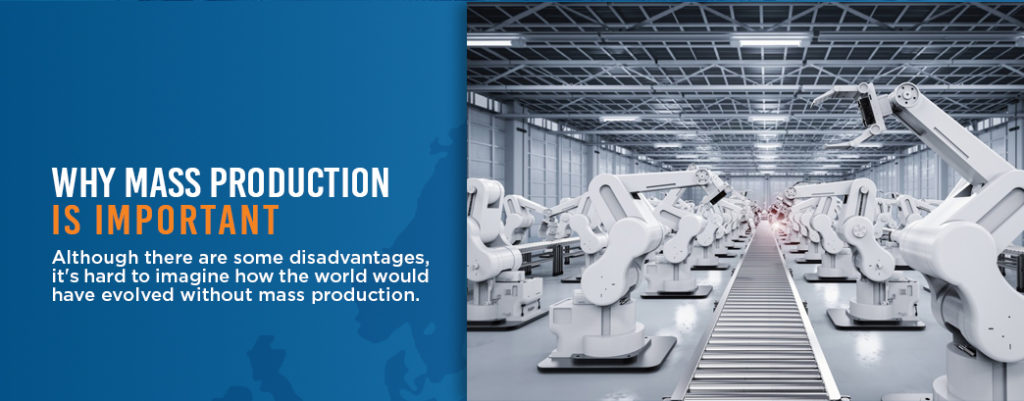
Although there are some disadvantages, it’s hard to imagine how the world would have evolved without mass production. Consider that the population in the United States before the Industrial Revolution was around 4 million. Compare that to 2018 when the population was estimated to be over 300 million in the United States. Regardless of the overall impact of mass production, the question is, how could the population manage without it?
One could argue that life before the Industrial Revolution and mass production was better for humankind and the environment. While there’s no doubt that mass production has impacted the environment, it’s been of great importance to people around the world. Let’s look at a few reasons why.
1. Lower Prices and Greater Access for All
Mass production enables people around the globe to acquire food, clothing, housing, medical supplies, cars and much more. In other words, it helps people survive and evolve. Before mass production, goods were made to order. It took time for consumers to get the products they demanded, and time costs money. Today, manufacturers can quickly meet consumer demand and make a profit at the same time. Meanwhile, consumers save money because mass production is efficient.
Also, thanks to mass production, the average person has access to more resources. Wealthy individuals are no longer the only ones who can travel or learn a foreign language. The average person has access to technology that opens up a world of information and knowledge to them. Without mass production, the majority of people would not be connected to information and each other through devices like smartphones and laptops.
Consider how America was before Henry Ford started using assembly lines. Before cars were commonplace, people rode in horse-drawn carriages. Carriages were never mass produced, and they were only built if someone placed an order. Usually, only the wealthy ordered carriages because no one else could afford such a luxury. Things changed when Ford developed mass production techniques and built hundreds of cars per day. Suddenly, average American families could afford cars — this increased mobility. Americans were no longer stuck in the same town or the same job because they lacked transportation. They could progress down their own path.
Today, consumers who appreciate handmade goods still have the freedom to purchase unique, custom items from artisans. Some manufacturers are equipped to mass produce custom items. Because of mass production, consumers can also purchase more affordable mass-produced goods as they wish. Overall, people enjoy the freedom to choose when and what they buy.
2. The Bigger the Better for Companies and Consumers

Larger entities experience big savings when they have greater outputs, and this, in turn, allows them to offer lower prices to consumers. This is because it costs less to produce large volumes at once than it does to manufacture small quantities over time. Large companies also save when they buy raw materials in bulk and use them to mass produce goods. They can also pass these savings on to consumers. In general, the bigger the entity and the more production power they have, the less it costs to produce goods.
3. Paved the Way for Mass Customization

Without the mass production system, mass customization would not exist. Mass customization refers to producing custom products quickly with low unit costs. This allows manufacturers to meet consumer demand. If a customer wants a certain design or feature, without high prices, manufacturers can deliver when they have mass customization capabilities. Furniture companies, for example, often offer customers the opportunity to choose from different fabrics or components. They have the resources to mass produce furniture while still creating personalized items.
Many consumers value customization. One study, published in Heliyon, found that some consumers feel emotionally attached to products that have been customized and match their preferences. Manufacturers who do not want to get left behind can consider how they can incorporate mass customization in their system.
Subscribe to Our Blog for More Info

Companies value mass production for a good reason – it leads to lower costs, higher profits and satisfied customers. Part of staying ahead of the game is staying informed. At Global Electronic Services, we strive to help companies reach their goals, whether we’re making a repair or sharing industry news. For more information, tips and advice on plant maintenance, subscribe to our blog today!